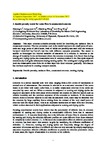A double-porosity model for water flow in unsaturated concrete
| dc.contributor.author | Li, D | |
| dc.contributor.author | Li, Long-yuan | |
| dc.contributor.author | Wang, X | |
| dc.contributor.author | Xing, F | |
| dc.date.accessioned | 2017-09-28T08:20:28Z | |
| dc.date.available | 2017-09-28T08:20:28Z | |
| dc.date.issued | 2017-09-14 | |
| dc.identifier.issn | 0307-904X | |
| dc.identifier.issn | 1872-8480 | |
| dc.identifier.uri | http://hdl.handle.net/10026.1/9993 | |
| dc.description.abstract |
This paper presents a double-porosity model for describing the moisture flow in unsaturated concrete. The two porosities used in the model represent the small pores of nano-scale and large pores of micro-scale, both of which are partially saturated with the moisture transport described by Darcy's law but with different transport properties. The model is applied to investigate the internal variation of saturation in a concrete in response to the change of humidity in the environment where the concrete is exposed. It is found that during wetting and drying cycles, the desaturation zone in concrete created in the first cycle expands continuously during the subsequent drying-wetting cycles. The wetting and drying cycles can push the desaturation zone from the surface layer into inner concrete gradually. This feature has not been explored in existing transport models. | |
| dc.format.extent | 510-522 | |
| dc.language | en | |
| dc.language.iso | en | |
| dc.publisher | Elsevier BV | |
| dc.subject | Double-porosity | |
| dc.subject | Moisture flow | |
| dc.subject | Unsaturated concrete | |
| dc.subject | Wetting | |
| dc.subject | Drying | |
| dc.title | A double-porosity model for water flow in unsaturated concrete | |
| dc.type | journal-article | |
| dc.type | Journal Article | |
| plymouth.author-url | https://www.webofscience.com/api/gateway?GWVersion=2&SrcApp=PARTNER_APP&SrcAuth=LinksAMR&KeyUT=WOS:000423247300032&DestLinkType=FullRecord&DestApp=ALL_WOS&UsrCustomerID=11bb513d99f797142bcfeffcc58ea008 | |
| plymouth.volume | 53 | |
| plymouth.publication-status | Published | |
| plymouth.journal | Applied Mathematical Modelling | |
| dc.identifier.doi | 10.1016/j.apm.2017.09.022 | |
| plymouth.organisational-group | /Plymouth | |
| plymouth.organisational-group | /Plymouth/Faculty of Science and Engineering | |
| plymouth.organisational-group | /Plymouth/Faculty of Science and Engineering/School of Engineering, Computing and Mathematics | |
| plymouth.organisational-group | /Plymouth/REF 2021 Researchers by UoA | |
| plymouth.organisational-group | /Plymouth/REF 2021 Researchers by UoA/UoA12 Engineering | |
| plymouth.organisational-group | /Plymouth/Research Groups | |
| plymouth.organisational-group | /Plymouth/Research Groups/Marine Institute | |
| plymouth.organisational-group | /Plymouth/Users by role | |
| plymouth.organisational-group | /Plymouth/Users by role/Academics | |
| dcterms.dateAccepted | 2017-09-06 | |
| dc.rights.embargodate | 2018-9-14 | |
| dc.identifier.eissn | 1872-8480 | |
| dc.rights.embargoperiod | Not known | |
| rioxxterms.versionofrecord | 10.1016/j.apm.2017.09.022 | |
| rioxxterms.licenseref.uri | http://www.rioxx.net/licenses/all-rights-reserved | |
| rioxxterms.licenseref.startdate | 2017-09-14 | |
| rioxxterms.type | Journal Article/Review |


